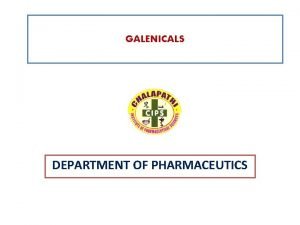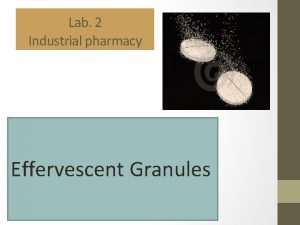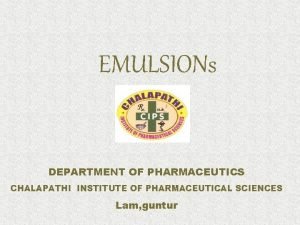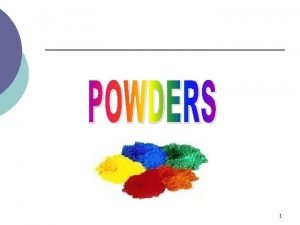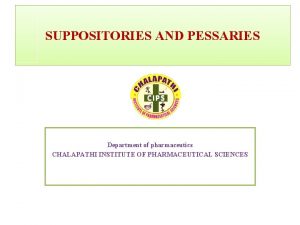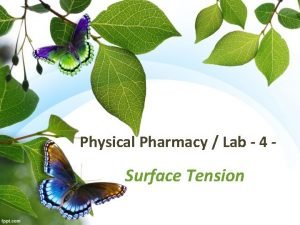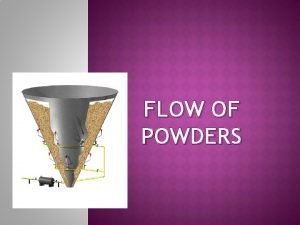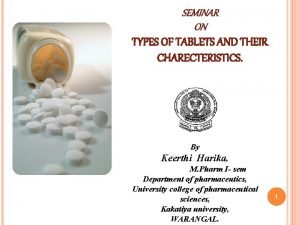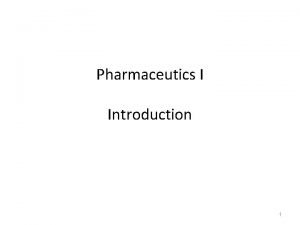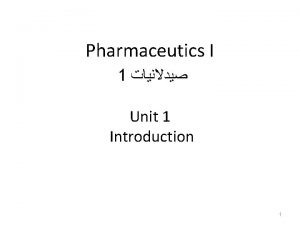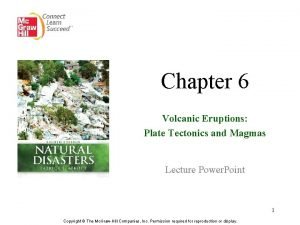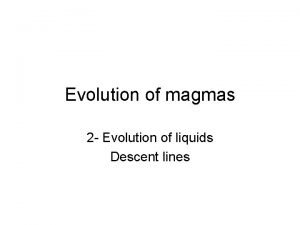Gells and Magmas 2 nd prof Pharmaceutics II
















- Slides: 16

Gells and Magmas 2 nd prof Pharmaceutics II

Introduction Gels are an excellent formulation for several routes of administration. They are useful as liquid formulations in oral, topical, vaginal, and rectal administration. Gels can be clear formulations when all of the particles completely dissolve in the dispersing medium. Definition: Pharmaceutical gels are semisolid systems in which there is interaction (either physical or covalent) between colloidal particles within a liquid vehicle. OR Are semisolid systems consisting of either suspensions made up of small inorganic particles or large organic molecules in a liquid vehicle rendered jelly like by the addition of a GELLING AGENT. Sometimes called JELLIES The vehicle may be: �Aqueous �Hydro alcoholic �Alcohol based Or �Non Aqueous

Terminologies related to gel Imbibition: Taking up of a certain amount of liquid without a measureable increase in volume Swelling: Taking up of a liquid by gel with an increase in volume Syneresis: Form of instability in which separation of solvent phase occurs coz of elastic contraction of polymeric molecules Thixotropy: A phenomenon in which if gel is agitated it may become fluid and remain in solid state only after remaining undisturbed for a period of time i. e sol gel transfer

GELLING AGENT Gelling agent are material used to thicken & stabilize liquid solutions. They dissolve in the liquid as colloid mixture that forms an internal structure giving the resulting gel an appearance of a solid matter. COMMON GELLING AGENTS ARE: �Acacia �Pectin �Strarch �Tragacanth �Xanthan gum �Alginic acid (seaweed) �Animal/vegitable fats: lard, cocoa butter �Gelatin �Bentonite, veegum (magnesium aluminum silicate) �Carboxymethylcellulose (CMC) and other cellulose derivatives �Carbomer resins (carbopols) �Colloidal silicon dioxide �Polyvinyl alcohol (PVA) �Petrolatum, mineral oil/polyethylene gel.

Characteristics of Gels may be thicken on standing, forming a THIXOTROPE, and must be shaken before use to liquefy the gel and enable pouring – Aluminum Hydroxide Gel Because of high degree of attraction between the dispersed phase and water medium, the gels remain fairly uniform upon standing and does not readily settle

CLASSIFICATION OF GELS On the Basis of Number of Phases 1 SINGLE-PHASE GEL : Single phase gel consist of organic macromolecules distributed uniformly throughout a liquid. EXAMPLES: Carbomer , Tragacanth 2 TWO PHASE GEL: Gels that contain small, discrete particles, Are thixotropic (semisolid on standing but liquid when shaken) EXAMPLE: Aluminum hydroxide

CLASSIFICATION OF GELS On the Basis of Continuous Phase. 1 ORGANOGELS Solid material composed of liquid organic phase entrapped in three dimensional cross linked network. Non-crystalline, Non-greasy, Thermoplastic Uses: In pharmaceutical industry. In cosmetics and food industry. 2 HYDROGELS It is a network of polymer chains that are hydrophilic or colloidal gel in which water is the dispersion medium. Highly absorbent, Degree of flexibility Uses: As scaffolds in tissue engineering. As environment sensitivity detector. Sustained release DDS. Provide absorption and debriding. Contact lenses. ECG medical electrode. Dressing of healing.

CLASSIFICATION OF GELS 3 XEROGELS Gels in which vehicles has been removed, leaving a polymer network (e. g. ) polymer film. Use: Used in Drug delivery system. On the Basis of Nature of Bond involved in 3 Dimensional Solid Network. 1. Dispersed solids 2. Hydrophilic polymers i) Type I ii) Type II

CLASSIFICATION OF GELS DISPERSED SOLIDS : Dispersed solids will undergo flocculation. The nature of interaction between particles in network may be Vander Waals or electrostatics interaction. Examples: Al-hydroxide gel USP , Kaolin HYDROPHILIC POLYMERS : Hydrophilic polymers are dispersed within appropriate aqueous phase. a)Type I: Irreversible system with 3 dimensional network formed by a covalent bonds between macromolecules. Example: Network is formed by polymerization of monomers of water soluble polymer in the presence of cross linking agents. b) Type II: Reversible system in which interaction occurred between polymers by a hydrogen bonding. Temporary destruction of bonds when stress applied thus formulation enable to flow.

MAGMA Two phase systems with large particle size or floccules of small distinct particles are called “MAGMA”. It is commonly known as Milk Magnesia. EXAMPLE: BENTONITE MAGMA

Preparation of Magmas and Gels: FUSION METHOD: In this method various waxy materials employed as gellant in non polar media. Drug is added when waxy materials melted by fusion. stirred slowly until uniform gel formed. COLD METHOD : Water is cooled to 4 -10ºc and placed it in mixing container. Gelling agent is slowly added and agitating until solution is complete. Maintained temperature below 10ºc. Drug is added in solution form slowly with gentle mixing. Immediately transfer to container & allow to warm to R. T where upon liquid becomes clear gel. DISPERSION METHOD : Gelling agent is dispersed in water with stirring at 1200 rpm for 30 min. Drug is dissolved in non-aqueous solvent with preservative. This solution is added in above gel with continuous stirring.

Preparation of Magmas and Gels: Some magmas and gels (inorganic) are prepared by freshly precipitating the disperse phase to achieve a fine degree of subdivision of the particles and a gelatinous character to those particles. The desired gelatinous precipitate results when solutions of inorganic agents react to form an insoluble chemical having a high attraction for water. As the microcrystalline particles of the precipitate develop, they strongly attract water to yield gelatinous particles, which combine to form the desired gelatinous precipitate. • Example: Preparation of Al(OH)3 gel is by reacting Al(Cl)3 + Na 2 CO 3 + Na. HCO 3

Preparation of Magmas and Gels: Other magmas and gels may be prepared by directly hydrating the inorganic chemical, which produces the disperse phase of the dispersion. In addition to the water vehicle, other agents as propylene glycol, propyl gallate, and hydroxypropyl cellulose may be used to enhance gel formation. • Al 2 O 3 + H 2 O Al(OH)3 • Examples: Aluminum Hydroxide Gel; Alugel; Amphogel; Ce-lu-gel; Cremalin; Hydroxal; Vanogel; Aluminum Phosphate Gel (Phosphagel) Antacid

USES OF GEL: Lubricant for catheters • Bases for patch testing • Na. Cl gel for electrocardiography • Floucinonide Gel for anti- inflammatory corticosteroid • Na Fluoride & Phosphoric acid gel – dental care prophylactic • Tretionoin Gel for treatment of acne • Prostaglandin Gel – intravaginal

IMPORTANCE OF MAGMAS AND GELS IN DOSAGE FORM Glycogelation gels are frequently used as a basis for medicated pastilles. They are also used in the formulation of some suppositories. E. g. Glycerin suppositories BP. Gelatin gels are employed in the preparation of hard and soft capsules that may be used to mask the unpleasant tastes of solid and liquids. IN MICROBIOLOGICAL MEDIA: - Agar and gelatin gels are used as solid media for the culture of micro-organism

IMPORTANCE OF MAGMAS AND GELS IN DOSAGE AS A LUBRICATING AGENT : - Gels also used as a lubricating agent in pharmaceutical preparation. It is mainly used as a drug delivery vehicle. lubricating gels are also used as a resistance of gamma radiation. It is harmless to skin, delicate tissues and mucous membranes. Other uses Cosmetic and styling tools: Hair gel to control hair, make hair shiny or even to flatten hair. Body gel to make skin smooth, shiny and soft. Silicone gel used to fill breast implants and to cover scars on the body or face.
 üledékes ércképződés
üledékes ércképződés Magmas dosage form
Magmas dosage form Steam jacketed percolator
Steam jacketed percolator Various methods of size separation
Various methods of size separation Fusion method pharmacy
Fusion method pharmacy Classify emulsifying agents with example
Classify emulsifying agents with example Powders in pharmaceutics
Powders in pharmaceutics Suppositories slideshare
Suppositories slideshare Cst method in physical pharmaceutics
Cst method in physical pharmaceutics Explain surface tension
Explain surface tension Physical incompatibility in pharmaceutics
Physical incompatibility in pharmaceutics Therapeutic incompatibility
Therapeutic incompatibility Powder flowing angle
Powder flowing angle Phase rule physical pharmacy
Phase rule physical pharmacy What is levigation in compounding
What is levigation in compounding Miscellaneous suppository base
Miscellaneous suppository base Hypodermic tablets examples
Hypodermic tablets examples


